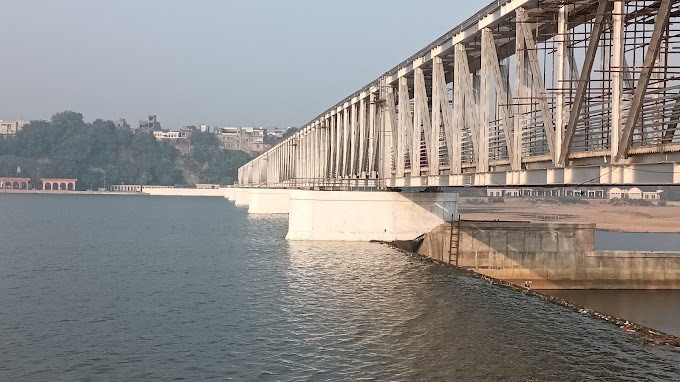Inside area

The dam stretches 411 meters across the Falgu River and is built using durable 17mm thick rubber, which can be inflated or deflated to control water flow. When inflated, it holds back water, ensuring the river retains enough depth for pilgrims to perform sacred rituals like Pind Daan throughout the year. The site features a well-constructed steel footbridge, offering safe and scenic passage across the river, connecting visitors to important religious spots like the Sita Kund. The surrounding area includes paved walkways, sitting zones, and landscaped riverbanks, making it a pleasant spot for both spiritual and leisure visits. With regular upkeep, the interior environment of the dam promises a blend of engineering marvel and cultural relevance, offering a peaceful and meaningful experience.
Other Attractions
The Gaya Rubber Dam is not only a modern engineering marvel but also surrounded by several spiritual and cultural attractions. Just beside the dam lies the sacred Vishnupad Temple, one of the most revered pilgrimage sites in Hinduism, believed to be built on Lord Vishnu’s footprint. Pilgrims flock here throughout the year, especially during Pitripaksha Mela, to perform ancestral rites. Nearby, visitors can explore the Sita Kund, a small yet spiritually significant spot connected to the Ramayana. The falgu Riverbanks, now beautified thanks to the dam, offer peaceful spots for reflection and photography. Additionally, the Gayaji Footbridge over the dam provides a scenic view of the river and temple, making it a great place for walks and photos. Together, these attractions create a meaningful and enriching experience for those visiting the rubber dam in Gaya.

Distance From
Gaya Railway Station
The Gaya Rubber Dam is approximately 3 km from Gaya Railway Station, taking around 10–15 minutes by road.

Gaya Airport
The Gaya Rubber Dam is approximately 9 km from Gaya Airport, taking around 20–25 minutes by road.

Gaya Bus Stand
The Gaya Rubber Dam is approximately 4 km from Gaya Bus Stand, taking around 10–15 minutes by road.

Our Review
The Gaya Rubber Dam, also known as Gayaji Dam, is a significant infrastructure project built to ensure a continuous water flow in the Falgu River near Vishnupad Temple. Our visit to the site revealed a well-constructed structure with a modern design, offering an enhanced experience for pilgrims performing religious rituals like Pind Daan. One of the major positives of the dam is its year-round water retention capability, which has helped maintain the sacred water body for devotees. The steel footbridge is another useful addition, providing easy access to the riverbanks and nearby religious sites. The surrounding area is clean and well-maintained, making it a peaceful place for visitors. However, during our visit, we noticed some challenges with water retention. Due to silt accumulation, certain sections of the river near the dam had dried up, forcing some pilgrims to source water from alternative locations. Regular maintenance and proper water management are necessary to ensure the dam functions efficiently. Despite these minor concerns, Gayaji Dam remains a valuable project, blending modern engineering with cultural and religious traditions. It has improved the overall experience for visitors and holds great potential if maintained properly. It is definitely worth visiting for its significance and scenic beauty.
